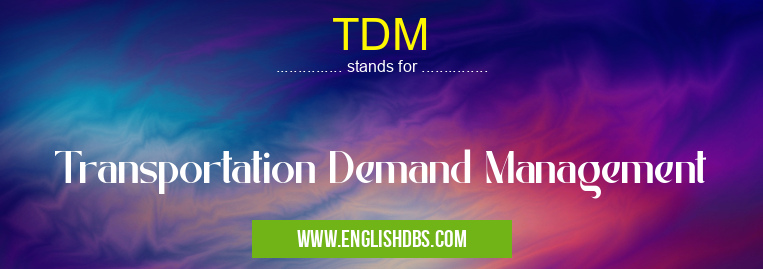What does TDM mean in TRANSPORTATION
Transportation Demand Management (TDM) is an approach used by governments around the world to reduce traffic congestion, pollution, and improve transportation system efficiency. TDM strategies focus on encouraging commuters to choose more efficient modes of transportation such as public transit, walking, biking, carpooling, or ridesharing. By reducing the number of vehicles in the road at peak times and spreading out demand throughout the day, TDM creates a more sustainable transport network that better serves everyone.

TDM meaning in Transportation in Governmental
TDM mostly used in an acronym Transportation in Category Governmental that means Transportation Demand Management
Shorthand: TDM,
Full Form: Transportation Demand Management
For more information of "Transportation Demand Management", see the section below.
Benefits of TDM
When implemented properly and with effective communication between citizens and local authorities about why it's important, TDM can bring several benefits to both individuals and cities alike. Some of those benefits include improved air quality as well as reduced noise levels due to decongested roads; increased mobility options; decreased financial costs associated with congested roads; better health outcomes from increased active transport options; improved access to jobs for citizens who are unable or unwilling to drive but instead rely upon public transport or other active modes; improved safety due to fewer vehicles travelling at high speeds in close proximity; reduced stress levels from knowing there will be fewer vehicle queues when you travel; among many others.
Essential Questions and Answers on Transportation Demand Management in "GOVERNMENTAL»TRANSPORTATION"
How can Transportation Demand Management (TDM) help reduce traffic?
Transportation Demand Management (TDM) is a set of strategies designed to promote the efficient and sustainable use of transportation systems. These strategies focus on promoting public transit, walking, cycling, carpooling, and other modes of transportation that are less likely to generate demand for single occupant vehicles. By providing people with more alternatives to driving alone, TDM can help reduce traffic congestion and its associated economic costs.
What are some examples of TDM initiatives?
TDM initiatives can be implemented at any level – from households up to entire regions. Examples include workplace incentives such as teleworking or flexible schedules; ridesharing programs; discounted public transit passes; park-and-ride lots; bicycle and pedestrian programs; pricing policies that discourage car use; employer subsidies for alternative modes of transport; improved transit services in underserved areas; and travel planning services.
How do TDM guidelines benefit businesses?
Businesses benefit from TDM guidelines by saving money on parking construction costs and providing employees with better access to work through alternative modes of transportation. Additionally, employers who offer transit benefits may be eligible for tax credits, making it more cost effective for them to provide this type of assistance to their staff. Companies also save money when employees carpool or ride share because it reduces the need for parking spaces or building expansion.
How does TDM help the environment?
By promoting more efficient use of existing infrastructure and encouraging shifts away from fossil fuel-powered transportation options (e.g., cars), TDM helps reduce air pollution levels and greenhouse gas emissions associated with motor vehicle usage. It also increases mobility choices which lessen reliance on individual cars while increasing connectivity between cities and towns – enabling better access to employment opportunities, education, healthcare, recreational activities, etc., without necessarily increasing overall vehicle trips.
Does TDM apply only to urban areas?
No – although heavily urbanized areas tend to have more need for implementing effective traffic management strategies due to higher population densities which generate greater amounts of road traffic, any community can enjoy the benefits afforded by TDM initiatives – such as reduced infrastructure maintenance costs, improved air quality levels, increased safety levels for pedestrians and cyclists, improved access to public transportation services and so forth.
What other benefits does implementing a successful TDM plan bring?
Implementing a successful TDM plan results in multiple benefits beyond simply reducing traffic congestion - in addition to those mentioned above - such as improved public health outcomes due increased physical activity amongst commuters who make use of active transportation like walking or biking, enhanced economic competitiveness through support services that permit remote working opportunities, social sustainability through better integration between different communities within a city or region, increased job mobility through improved accessibility between different residential neighborhoods.
How can I find out about local initiatives that aim towards improving traffic flow using Transportation Demand Management techniques?
You can contact your local transport authority/municipal government offices in order to gain information about any ongoing or planned projects related specifically towards improving traffic flow within your area via the means of Transportation Demand Management approaches being employed by them. Alternatively you could look up online databases like Government Investment Opportunities Database (GIODB) maintained by Invest India which provides information about potential investment opportunities across sectors in various states as well as union territories.
Are there any grants available related towards supporting projects directed towards Traffic Flow Improvement via TDs?
Yes,there are grant schemes available from both the Central Government as well as State Governments aimed towards supporting projects related towards Improving Traffic Flow conditions via implementation of Transportation Demand Management strategies. You could approach your Municipal Authorities regarding this matter in order avail any such grant opportunities.
Final Words:
Through its multiple benefits, Transportation Demand Management can be seen as an effective tool for governments looking for an efficient way towards reducing traffic congestion while also providing greater mobility choice for citizens. As cities become increasingly crowded - especially during peak hours - it's essential that new ways are developed so that citizens can still reach their destinations without having to fear such delays caused by heavy traffic.
TDM also stands for: |
|
| All stands for TDM |
